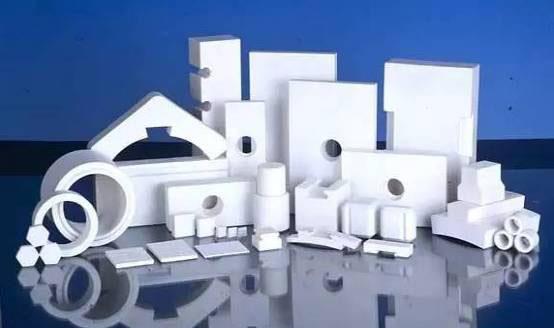As a new type of high purity material, the role of high purity alumina is expanding. High purity alumina is white powder, uniform particle size, easy to disperse, chemical properties are also very stable, high temperature shrinkage performance is moderate, has a good sintering performance conversion rate, is the production of heat resistance, wear resistance, corrosion resistance of the basic raw materials. The use of high purity alumina is also used for light-permeable alumina sintered body, fluorescent carrier, special gas additives and many other aspects, the scope of application can be said to be very wide.
1. Sapphire application
Sapphire is a single crystal of alumina (α-Al2O3), also known as corundum. As an important technical crystal, sapphire has been widely used in many fields of science and technology, national defense and civil industry.

Sapphire crystal has excellent optical properties, mechanical properties and chemical stability, high strength, hardness, erosion resistance, and can work in the harsh conditions close to 2000℃ high temperature. Sapphire crystal has unique lattice structure, excellent mechanical properties, good thermal properties.
The main uses of sapphire crystal:
1. Widely used in infrared military devices, satellite space technology, high intensity laser window materials. It is the most ideal substrate material for semiconductor GaN/Al2O3 light-emitting diode (LED), large-scale integrated circuit SOI and SOS and superconducting nanostructured film. 2. It is used in the semiconductor lighting industry, such as LED, which is a new generation of light source and is recognized as the most promising high-tech field in the 21st century. LED can improve the luminous efficiency by nearly 10 times, the service life is more than 20 times that of traditional lamps, both green, environmental protection and other advantages. Now the world's major countries and regions have developed LED technology and industrial development plans, but at present can be used for LED production of commercial substrate only two, namely sapphire and silicon carbide substrate, and at present 80% of the global LED enterprises commercial production using sapphire as substrate, so sapphire has a huge market application prospects. 3 Used in civil aerospace, military, such as wave window, fairing, photoelectric window, guard plate, gyro, wear-resistant bearing and other parts. Military photoelectric equipment, such as: photoelectric pod, photoelectric tracker, infrared warning system, submarine photoelectric mast, etc. Sapphire crystal in civil applications, such as the scanning window of bar code scanner, never wear type radar watch mask, textile industry fiber wire guide, camera lens, wear-resistant bearings.
2. From the functional perspective, high purity alumina has electrical, optical, chemical, biological, sound absorption, thermal, mechanics and other functions, the main application areas are as follows:

Electrical materials: integrated circuit substrate, packaging, spark plug, Na-S battery solid electrolyte. (with 4N high purity nano-alumina granulation powder, VK-L05C)2 optical function: high pressure sodium vapor lamp light tube, laser material, sensor. (with 5N high purity nano-alumina VK-L100G)3 Chemical function: control chemical reaction, purification and discharge gas, catalyst carrier, corrosion resistant material, solid enzyme carrier. 4 Biological functions: artificial bone, artificial tooth root, (with 5N high purity nano-alumina VK-L100G)5 Thermal functions: heat resistance, heat insulation structural materials 6 mechanical functions: grinding materials, cutting materials, bearings, precision machinery parts.
3. Application of high-purity nano-alumina fine ceramics: nano-alumina fine ceramics prepared with nano-alumina as the main raw material have been applied in high-tech fields and many industries because of their various functions:
Applications in the electronics industry

(1) Ceramic multilayer substrate for multi-chip packaging: there are four manufacturing methods of nano-alumina ceramic multilayer substrate for packaging: thick film printing method, green slab method, green slab printing method, thick and thin film mixing method.
(2) High-pressure sodium lamp tube: nano-alumina transparent body formed by polycrystalline opaque high purity nano-alumina (VK-L100G, 99.999%), applied in high-pressure sodium lamp tube, lighting efficiency is twice that of mercury lamp, thus opening up a new way to improve the lighting efficiency. Transparent and high purity nano-alumina fine ceramics can not only light transmittance, but also have high temperature resistance, corrosion resistance, high insulation, high strength, low dielectric loss and other properties, is a kind of excellent optical ceramics, can also be used as microwave window, etc.
(3) nano-alumina ceramic sensor: with high purity nano-alumina (VK-L100G) ceramic grain, grain boundaries, pores and other structural characteristics and characteristics as sensitive elements, for high temperature and corrosive gas environment, so that the detection, control information accurate and rapid. From the type of application, there are temperature, gas, temperature sensors.
2. Biological nano high purity alumina (VK-L100G) ceramics
High purity alumina polycrystalline as a biological functional material and applied to the human body in 1969, high purity alumina fine ceramics used in medical engineering are single crystal and sintered polycrystalline two kinds. At present, the United States, West Germany, Switzerland and the Netherlands are widely using polycrystalline high-purity nano-alumina to make artificial teeth and artificial bones. The medical materials are mainly high-purity nano-alumina, which is used for tooth roots and joints. The contact Angle between nano-alumina fine ceramics and human tissue fluid is the material closest to human teeth. So far, there are more than 20 kinds of bioceramics used in medical engineering, and high purity nano-alumina is the most widely used one.
3. Nano-alumina (VK-L05C) ceramic tool
The hardness (Hr) of nano-alumina is 2700~3000, and the Young's modulus (kg/mm2) is 35000~41000. Thermal conductivity coefficient is 0.75 ~ 1.35 x 103 j/m. h. ℃, thermal expansion coefficient of 8.5 x 10-6 / ℃ (room temperature to 1000 ℃). While taking advantage of these characteristics, Al2O3-tio2, Al2O3-ZRO2 series ceramics have been developed to improve the toughness and heat resistance of nano-alumina ceramic tools. The particle size composition of Al2O3 in the sintering process of nano-alumina grain size control is an important link to determine the quality of the tool. If high temperature isostatic sintering (HIP) is used, The grain size can be 0.3~0.5 micron. The bending strength of nano-alumina tool can be increased to 900~1000MPa, which is suitable for high-speed cutting.
The above can be seen, high purity alumina as a new high purity material, in recent years development is particularly rapid, and more widely used.
Copyright © 2022 Zhejiang Jingpeng Zirconium Technology Co., Ltd All Rights Reserved. 浙ICP备12046652号 XML地图
技术支持:易企推